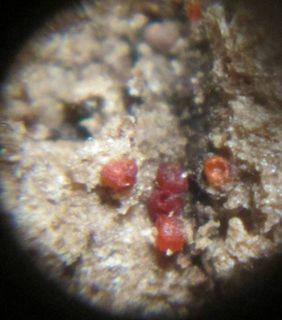Stylonectria
| Stylonectria | ||||||||||||
|---|---|---|---|---|---|---|---|---|---|---|---|---|

Stylonectria purtonii |
||||||||||||
| Systematics | ||||||||||||
|
||||||||||||
| Scientific name | ||||||||||||
| Stylonectria | ||||||||||||
| Heck. |
Stylonectria is a genus from the family of pustule relatives (Nectriaceae). The type species is Stylonectria applanata .
features
Teleomorphs
The stromata are thin and whitish or yellow in color. They act like hyphae or a subiculum . The perithecia appear gregarious in groups of up to 20 individuals. They are spherical, pear-shaped to sub-cylindrical in shape and have a rounded or wide, flattened, round disc. In dry weather, they sometimes dip sideways. The perithecia are 150 to 250, sometimes up to 350 µm high. They are pale yellow, orange-red, orange-brown or pale to dark red in color. With KOH , the perithecia turn dark red to purple; they react yellow with lactic acid . The surface is smooth, usually shiny and somewhat iridescent.
The wall of the perithecia consists of two layers. The inner layer is hyaline , thin-walled, indented and made up of elongated cells. The outer layer consists of isodiametric to elongated, angular to spherical, thick-walled cells. The asci are cylindrical to club-shaped. The top is simple and has a ring on it. The tubes form eight uniseriate, biseriate, or irregularly directed Asco spores . These are hyaline or yellow to pale brown and simply septate . They are cylindrical to allantoid in shape, smooth to warty and generally thick-walled.
Anamorphic
The conidiophores are initially mostly formed as unbranched phialides on somatic hyphae . Often they are loosely branched; sometimes they form small sporodochia . The phialids are almost cylindrical in shape and often have a small collar . They each form a conidia .
Microconidia are sparsely formed. They are allantoid to sickle-shaped, slightly to strongly curved and unseptate . They are formed in slimy heads. The macroconidia are sub-cylindrical or slightly to strongly curved, mostly not or simply septate and appear in mass orange. They are narrower at the top than at the base. The apical cell is blunt or bent over; the basal cell is hardly or not at all pedicellate. Chlamydospores are not known.
In culture, the colonies on PDA grow slowly to very slowly. In 14 days at room temperature they can reach a diameter of 10 to 30 mm. They are white but later turn off-white to pale or light orange. Orange colored sporodochia are often present. Aerial mycelium is usually absent. If present, it is sparse and pressed. The edge is smooth to broadly lobed.
ecology
The mushrooms usually grow on the fruiting bodies of other ascomycota fungi , mainly on representatives of the order Diaporthales . The species of the genus Stylonectria are regarded as host-specific, with specialization in the mushroom host being assumed. These in turn specialize in certain types of plants.
Systematics
The genus Cosmospora contains the following species worldwide.
| Scientific name | Author quote |
|---|---|
| Stylonectria applanata | Heck. 1915 |
| Stylonectria carpini | Graefenhan 2011 |
| Stylonectria purtonii | (Grev. 1828) Graefenhan 2011 |
| Stylonectria wegeliniana | (Rehm 1891) Graefenhan, Voglmayr & Jaklitsch 2011 |
Taxonomy
Stylonecrtia was described in 1915 by Franz Xaver Rudolf von Höhnel as an anamorphic genus . At that time it consisted only of the S. applanata type . As Teleomorphs was "Nectria" applanata var. Succinea viewed. Later, however , Colin Booth was able to prove that S. applanata is a main form of fruit.
swell
literature
- T. Graefenhan, H.-J. Schroers, HI Nirenberg, KA Seifert: An overview of the taxonomy, phylogeny and typification of nectriaceous fungi in Cosmospora , Acremonium , Fusarium , Stilbella , and Volutella . In: Amy Rossman, Keith Seifert: Phylogenetic revision of taxonomic concepts in the Hypocreales and other Ascomycota. A tribute to Gary J. Samuels. Studies in Mycology 68, 2011, pp. 79-113. ( PDF; 1.03 MB )
Individual evidence
- ↑ C. Booth: Studies of Pyrenomycetes IV. Nectria (part I). Mycological Papers 73, 1959, pp. 1-115.